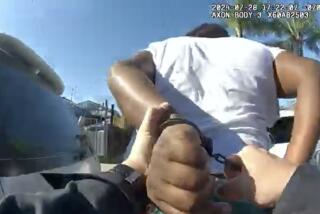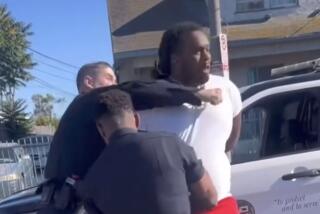Video of apparent police beating of Hong Kong protester sparks outrage
- Share via
Reporting from Beijing — A video apparently showing at least six plainclothes Hong Kong police officers dragging a handcuffed pro-democracy protester into a dark corner then kicking and beating him captivated and enraged many in the semi-autonomous Chinese territory on Wednesday.
The incident threatened to ratchet up tensions anew just as the protests that have paralyzed parts of the city for more than two weeks looked to be running out of steam.
Thousands of protesters returned to the Admiralty district Wednesday evening in a defiant mood, apparently galvanized by the alleged attack that some demonstrators were calling Hong Kong’s “Rodney King moment.”
“Why do you treat us as enemies?” asked Hong Kong Federation of Students deputy leader Lester Shum, angrily addressing police before the crowd in Admiralty. “Are you not also Hong Kongers? Will you not also enjoy what we’re trying to fight for? Why do you hit us?”
The man in the video was later identified as Ken Tsang, a member of the pro-democracy Civic Party and a volunteer social worker. After a trip to a hospital, Tsang appeared before local media and displayed injuries to his face, neck and torso. Tsang said he was beaten immediately after his detention and again at a police station, and he vowed to take legal action.
In a statement, the police force expressed concern over the video. “Police have already taken immediate actions and will conduct investigation impartially,” it said. “The Complaints Against Police Office has already received a relevant complaint and will handle it in accordance with the established procedures in a just and impartial manner.”
Secretary for Security Lai Tung-kwok told local media that the officers in question had been transferred to different duties.
In recent days, police have stepped up their efforts to reduce the areas held by the demonstrators, who have been protesting since late September and demanding open nominations of candidates for the city’s highest office in 2017. The central government in Beijing has rejected such a framework, insisting that all candidates must be approved by a special committee.
Authorities in Beijing have repeatedly denounced the protesters. A commentary carried by the Communist Party mouthpiece People’s Daily on Wednesday said the demonstrations were “doomed to fail.”
With demonstrations now in their third week, protest leaders conceded Wednesday they needed to reconsider their approach. “We need to think of strategies,” Chinese University of Hong Kong sociologist Chan Kin-man, a protest organizer, told the crowd, which later chanted, “Police are shameful!”
While expressing understanding for protesters who had blocked a key road early Wednesday, leading to the arrest of Tsang and 44 others, Chan said: “We need to be more strategic and not fall into their trap.”
Hong Kong’s secretary for constitutional and mainland affairs, Raymond Tam Chi-yuen, said Wednesday that the government had been using a middleman to liaise with the student federation for a direct dialogue. But the federation’s leader, Alex Chow, said the group had not been approached by any middleman and that he saw no sign of compromise from the government.
Choy Chi Keung, a lecturer in politics at the Chinese University of Hong Kong, said that with protests losing steam, “the chance that the government will offer any concessions is becoming dimmer and dimmer. The pressure on the government has been reduced.”
But those demonstrators that remain on the streets, Choy noted, are the most determined, “hard-core” supporters, which could raise the chance of further confrontations with authorities.
Speaking to Radio Television Hong Kong before the video surfaced, Steve Vickers, a former head of the police force’s criminal intelligence bureau, said Wednesday that in general, police have been using an “amazingly light touch.”
Vickers, who now runs a security consulting firm, said he was surprised that officers have not been using tear gas in recent days. “There seems to be a reluctance on the management to use [tear] gas,” he told RTHK. “That will mean there will be a lot more injuries, there will be a lot more people-on-people clashes that will lead to more injuries. As long as this goes on, I don’t see a very happy ending.”
Lee Cheuk Yan, chairman of the Hong Kong Alliance in Support of Patriotic Democratic Movements in China, also expressed concern.
“What we are worried about is that the government is looking for a violent clearance solution and not really listening to the people,” he said Wednesday night. The goal is still dialogue between the government and protesters, and it’s very important to find a political situation and not a violent situation.”
According to Tsang’s lawyer and Amnesty International, he was among 45 people arrested before dawn Wednesday as police sought to remove demonstrators who had set up roadblocks near government headquarters in Admiralty. Officers scuffled with demonstrators and used pepper spray to disperse protesters from the scene. Local broadcaster TVB captured the images of Tsang as he was escorted away by police officers wearing street clothes and black vests.
Tsang was initially charged with assaulting a police officer; those charges were later changed to unlawful assembly and obstructing officers from carrying out their duties, Amnesty International said.
Mabel Au, director of Amnesty International Hong Kong, said the incident appeared to be a “vicious attack against a detained man who posed no threat to the police.” “It is stomach-churning to think there are Hong Kong police officers that feel they are above the law.”
The Hong Kong police force has in recent decades enjoyed a sterling reputation for professionalism that dates back to the territory’s days as a British colony; Hong Kong returned to Chinese rule in 1997.
But since the unprecedented street protests erupted in late September, the force has faced criticism for initially using tear gas against protesters, and allegations of collusion with gang members seeking to intimidate the demonstrators. Outrage over the use of tear gas -- an exceptionally rare event in Hong Kong -- spurred many Hong Kongers to join the protests.
Leaders of the force have defended their decision to use tear gas, saying they feared the protests might lead to a stampede or a similarly dangerous situation. They have denied any links to criminal gangs.
But with the demonstrations now in their third week, stress has sapped morale among the force, according to Junior Police Officers’ Assn. Chairman Joe Chan Cho-Kwong.
“We start to be unable to distinguish right and wrong,” the police union chief said in an interview with the South China Morning Post.
Choy said it was likely the latest video would lead to a fresh round of criticism of the police because they have repeatedly emphasized that they are using only the minimum amount of force necessary to keep order. But whether it could galvanize a fresh round of protesters to pour into the streets, he said, was far from clear.
“As time passes, people are more and more exhausted,” he said. “And the voices against the movement, from others in society who are asking students to stop so they can resume daily life, those voices are growing.”
But Fion Ng, a college student who has been protesting since late September and was in Admiralty again Wednesday night, expressed a determination to stick things out.
“You have to be idealistic to negotiate with the government,” she said. “You are expecting that they are going to ask you to make concessions and compromise.”
Makinen and Silbert reported from Beijing. Ap reported from Hong Kong. Silbert and Ap are special correspondents. Nicole Liu in the Times’ Beijing bureau contributed to this report.
Follow @JulieMakLAT for news from China
More to Read
Sign up for Essential California
The most important California stories and recommendations in your inbox every morning.
You may occasionally receive promotional content from the Los Angeles Times.










